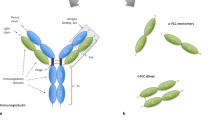Abstract
Background
The objective was to evaluate the precision of kappa and lambda free light chains (KFLC and LFLC) in CSF for the diagnosis of multiple sclerosis (MS) and prognosis of clinically isolated syndrome (CIS).
Methods
CSF and serum samples from CIS, MS and other neurological non-MS disease were collected between 2015 and 2017. FLC concentrations were measured using immunoassay Freelite™. Results were correlated with the patients’ diagnoses and ROC curve analysis was used to determine accuracy. In CIS patients, analysis of FLC were compared in CIS converters vs. non-converter during follow-up.
Results
In the MS group (n = 41), the optimal cut-off for KFLC determined was 7 mg/L, with a diagnostic sensitivity and specificity of 95% and 97%, respectively. The optimal cut-off for LFLC was 0.7 mg/L, with a diagnostic sensitivity and specificity of 71% and 81%, respectively. 36 CIS patients were included; mean follow-up time was 28 ± 9 months, and 22 (61.1%) patients converted to MS. The median concentration of CSF K and LFLCs at CIS diagnosis was slightly higher in CIS-converters compared to non-converters, but this did not reach statistical significance (KFLC: median 7 ± 5.3 mg/L vs. 5 ± 2.3 mg/L, p = 0.11; LFLC 0.7 ± 0.33 mg/L vs. 0.5 ± 0.23 mg/L p = 0.16). A strong correlation was observed between the concentration of K and L FLCs at diagnosis and the change in PBVC during follow-up (r = 0.72 and r = 0.65, respectively).
Conclusion
KFLCs have a high sensitivity and specificity for the diagnosis of MS. FLC concentrations at CIS diagnosis were not significantly higher in CIS-converters.


Similar content being viewed by others
References
Ebers GC (2008) Environmental factors and multiple sclerosis. Lancet Neurol 7(3):268–277
Lublin FD, Reingold SC, Cohen JA, Cutter GR, Sorensen PS, Thompson AJ, Wolinsky JS, Balcer LJ, Banwell B, Barkhof F et al (2014) Defining the clinical course of multiple sclerosis: the 2013 revisions. Neurology 83(3):278–286
Hassan-Smith G, Durant L, Tsentemeidou A, Assi LK, Faint JM, Kalra S, Douglas MR, Curnow SJ (2014) High sensitivity and specificity of elevated cerebrospinal fluid kappa free light chains in suspected multiple sclerosis. J Neuroimmunol 276(1–2):175–179
Voortman MM, Stojakovic T, Pirpamer L, Jehna M, Langkammer C, Scharnagl H, Reindl M, Ropele S, Seifert-Held T, Archelos JJ et al (2017) Prognostic value of free light chains lambda and kappa in early multiple sclerosis. Mult Scler 23(11):1496–1505
Corona T, Roman GC (2006) Multiple sclerosis in Latin America. Neuroepidemiology 26(1):1–3
Cristiano E, Rojas J, Romano M, Frider N, Machnicki G, Giunta D, Calegaro D, Corona T, Flores J, Gracia F et al (2013) The epidemiology of multiple sclerosis in Latin America and the Caribbean: a systematic review. Mult Scler 19(7):844–854
Presslauer S, Milosavljevic D, Brucke T, Bayer P, Hubl W (2008) Elevated levels of kappa free light chains in CSF support the diagnosis of multiple sclerosis. J Neurol 255(10):1508–1514
Presslauer S, Milosavljevic D, Huebl W, Parigger S, Schneider-Koch G, Bruecke T (2014) Kappa free light chains: diagnostic and prognostic relevance in MS and CIS. PLoS One 9(2):e89945
Polman CH, Reingold SC, Banwell B, Clanet M, Cohen JA, Filippi M, Fujihara K, Havrdova E, Hutchinson M, Kappos L et al (2011) Diagnostic criteria for multiple sclerosis: 2010 revisions to the McDonald criteria. Ann Neurol 69(2):292–302
Thompson AJ, Banwell BL, Barkhof F, Carroll WM, Coetzee T, Comi G, Correale J, Fazekas F, Filippi M, Freedman MS et al (2018) Diagnosis of multiple sclerosis: 2017 revisions of the McDonald criteria. Lancet Neurol 17(2):162–173
Rovira A, Wattjes MP, Tintore M, Tur C, Yousry TA, Sormani MP, De Stefano N, Filippi M, Auger C, Rocca MA et al (2015) Evidence-based guidelines: MAGNIMS consensus guidelines on the use of MRI in multiple sclerosis-clinical implementation in the diagnostic process. Nat Rev Neurol 11(8):471–482
Smith SM, De Stefano N, Jenkinson M, Matthews PM (2001) Normalized accurate measurement of longitudinal brain change. J Comput Assist Tomogr 25(3):466–475
Smith SM, Zhang Y, Jenkinson M, Chen J, Matthews PM, Federico A, De Stefano N (2002) Accurate, robust, and automated longitudinal and cross-sectional brain change analysis. Neuroimage 17(1):479–489
De Stefano N, Stromillo ML, Rossi F, Battaglini M, Giorgio A, Portaccio E, Hakiki B, Malentacchi G, Gasperini C, Santangelo M et al (2011) Improving the characterization of radiologically isolated syndrome suggestive of multiple sclerosis. PLoS One 6(4):e19452
Vrenken H, Jenkinson M, Horsfield MA, Battaglini M, van Schijndel RA, Rostrup E, Geurts JJ, Fisher E, Zijdenbos A, Ashburner J et al (2013) Recommendations to improve imaging and analysis of brain lesion load and atrophy in longitudinal studies of multiple sclerosis. J Neurol 260(10):2458–2471
Chard DT, Jackson JS, Miller DH, Wheeler-Kingshott CA (2010) Reducing the impact of white matter lesions on automated measures of brain gray and white matter volumes. J Magn Reson Imaging 32(1):223–228
Puthenparampil M, Altinier S, Stropparo E, Zywicki S, Poggiali D, Cazzola C, Toffanin E, Ruggero S, Grassivaro F, Zaninotto M et al (2018) Intrathecal K free light chain synthesis in multiple sclerosis at clinical onset associates with local IgG production and improves the diagnostic value of cerebrospinal fluid examination. Mult Scler Relat Disord 25:241–245
Ganelin-Cohen E, Golderman S, Yeskaraev R, Rozenberg A, Livneh A, Kaplan B (2018) Search for new biomarkers of pediatric multiple sclerosis: application of immunoglobulin free light chain analysis. Clin Chem Lab Med 56(7):1081–1089
Presslauer S, Milosavljevic D, Huebl W, Aboulenein-Djamshidian F, Krugluger W, Deisenhammer F, Senel M, Tumani H, Hegen H (2016) Validation of kappa free light chains as a diagnostic biomarker in multiple sclerosis and clinically isolated syndrome: a multicenter study. Mult Scler 22(4):502–510
Author information
Authors and Affiliations
Corresponding author
Ethics declarations
Conflicts of interest
Authors declare no conflict of interest with the research performed.
Rights and permissions
About this article
Cite this article
Sáez, M.S., Rojas, J.I., Lorenzón, M.V. et al. Validation of CSF free light chain in diagnosis and prognosis of multiple sclerosis and clinically isolated syndrome: prospective cohort study in Buenos Aires. J Neurol 266, 112–118 (2019). https://doi.org/10.1007/s00415-018-9106-2
Received:
Revised:
Accepted:
Published:
Issue Date:
DOI: https://doi.org/10.1007/s00415-018-9106-2




